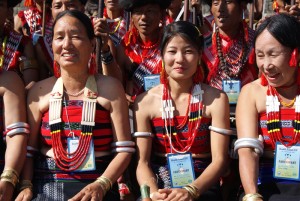 The seven sister states are in deep slumber year round but this one nudges herself awake every December. Once she is awake she doesn’t waste any time yawning or stretching; she hits the track running. Come the Hornbill Festival – December 1 to 7 – and Nagaland, coyly tucked away in the north eastern tip of India bursts open in a riot of colours, shudders with dizzying shrieks of martial folk dances and gets giddy on the aromatic highs of herbed bison meat and free flowing rice beer.
The seven sister states are in deep slumber year round but this one nudges herself awake every December. Once she is awake she doesn’t waste any time yawning or stretching; she hits the track running. Come the Hornbill Festival – December 1 to 7 – and Nagaland, coyly tucked away in the north eastern tip of India bursts open in a riot of colours, shudders with dizzying shrieks of martial folk dances and gets giddy on the aromatic highs of herbed bison meat and free flowing rice beer.
The state has some serious issues to tackle – like insurgency – which comes in the way of making a dent on the reveller map. However, the people more than make up for it – with their hospitality and love for stories. There are three kinds of stories in Nagaland: The War stories, documented pithily in bullet points in the War Museum in capital Kohima (or conjure up your own from the evocative epitaphs in the nearby cemetery – ‘Leslie, As long and life and memory last, I will always remember you. Dad’). The ‘UG’ or underground stories – of gentle extortion narrated with benevolent helplessness. And the valiant, mythological ones which have become folklores and given names to mountains, villages or festivals.
Historically yours. Culturally too
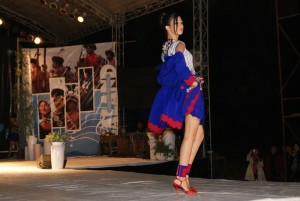 The Hornbill festival, in addition to its frenzied energy of motion, twirling colours and vibrant notes, holds several layers of relevance in the life of the modern Naga. With over half the population depending on agriculture, all the festivals are related to harvest cycles. Each of the 16 tribes has its own festivals through most part of the year, but they all come together for Hornbill. Though not easily discernible to the outside eye, each tribe member is distinguished in their own way from other tribes – could be in the coloured goat hair that ornament the spear or their daos (traditional knives), bamboo headgears plumed with wild orchids and hornbill feathers and wild animal teeth. The gala also doubles up as a display of solidarity among clans that have a long history of being at loggerheads with each other. Generous gifts and kind words are exchanged, intertribal interactions are greatly facilitated with harmony, peace and progress as the ultimate goals.
The Hornbill festival, in addition to its frenzied energy of motion, twirling colours and vibrant notes, holds several layers of relevance in the life of the modern Naga. With over half the population depending on agriculture, all the festivals are related to harvest cycles. Each of the 16 tribes has its own festivals through most part of the year, but they all come together for Hornbill. Though not easily discernible to the outside eye, each tribe member is distinguished in their own way from other tribes – could be in the coloured goat hair that ornament the spear or their daos (traditional knives), bamboo headgears plumed with wild orchids and hornbill feathers and wild animal teeth. The gala also doubles up as a display of solidarity among clans that have a long history of being at loggerheads with each other. Generous gifts and kind words are exchanged, intertribal interactions are greatly facilitated with harmony, peace and progress as the ultimate goals.
‘Window to Nagaland,’ announces the entrance to the festival venue and the Naga Bazaar set up temporarily did full justice to this proclamation. Those menacing daos which came in different shapes, so deftly handled by the performers during the folk dances were on sale here. Plumed headgears, ornamental spears, wooden masks…everything to convert experience into solid memories were available here. The craftsmanship of the Nagas is proudly displayed: while the women are adept in weaving and pottery the men are masters in wood and metalwork. Jewellery is also a flourishing cottage industry: the heavy spiral brass bangles are a big hit. School children picked up bamboo pen stands and housewives had an array of kitchen utensils to choose from. The ‘Night Bazaar’ was a culinary roller coaster with the omnipresent momos (steamed meat in dough duffels) to specialist dishes like smoked pork axione (pronounced ‘aah-hi-onay’) to bamboo vinegar and bottled rare herbs. In a state where liquor is traditionally banned, it is freely available. However the local brew of rice beer is the flavour of the season. While the main venue was at Kisama, 12 km from the Kohima town, the Night Bazaar was right in the capital itself, part of the plan to bring some action to the otherwise sleepy town.
Kigwema: Enter Nagaland’s Past
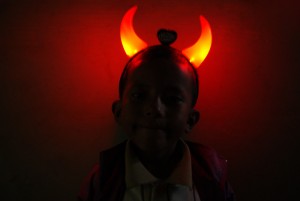 Hornbill has been quite flighty when it comes to locations over the years. The first one, in 2000, was held in Kohima before it was shifted to its present venue, Kisama, in 2003. After detailed discussions between the government and the village elders, land was acquired to give it a permanent address from two villages – Kigwema and Phesama. The new name is the outcome of an unimaginative coinage of the two names which fortunately threw up a most apt meaning – ‘new village’. If Kisama was the ‘Window to Nagaland,’ a visit to Kigwema makes you feel that you are entering through the door. Kigwema village, 5 km from the main festival venue, is a true slice of Nagaland decked in its traditional fineries and still on the fringes of its glorious past. A walk through the tidied up winding walkways of the village, eerily quiet at two in the afternoon, takes you back in time.
Hornbill has been quite flighty when it comes to locations over the years. The first one, in 2000, was held in Kohima before it was shifted to its present venue, Kisama, in 2003. After detailed discussions between the government and the village elders, land was acquired to give it a permanent address from two villages – Kigwema and Phesama. The new name is the outcome of an unimaginative coinage of the two names which fortunately threw up a most apt meaning – ‘new village’. If Kisama was the ‘Window to Nagaland,’ a visit to Kigwema makes you feel that you are entering through the door. Kigwema village, 5 km from the main festival venue, is a true slice of Nagaland decked in its traditional fineries and still on the fringes of its glorious past. A walk through the tidied up winding walkways of the village, eerily quiet at two in the afternoon, takes you back in time.
There still stands houses made from huge planks of the hardest timber with an array of animal skulls looking down from the top; more the number of the skulls, the higher would be the family’s social standing. Embers still smouldered in the village square where elders were lazing away the afternoon after a hearty lunch; decisions pertaining to land or property feuds, love affairs, division of a public utility were still taken here. Village damsels in colourful western dresses were washing clothes, amidst chirping village gossip by the foot of a large circular cement tank. The elder women sat on porches de-chaffing rice from the granary for dinner. Little girls were bringing in firewood and tending to kitchen gardens.
In and around
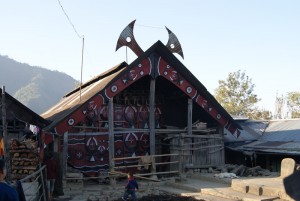 The aftermath of the World War, the exploits of the plundering army, the three-month long face-off by the Allied forces, all have been faithfully documented in the War Museum at Kohima. Right in the heart of the town is the War Cemetery dedicated to the memory of over 10,000 soldiers who lost their lives before finally managing to push the enemy back over the border; here an endless array of headstones are arranged neatly with evocative epitaphs (‘Leslie, As long as life and memory last, I will always remember you. Dad’). The Catholic Church on the Aradurah Hill in Kohima is among the biggest church in the predominantly Christian north eastern India. A serene piece of architecture, the church is beguilingly quiet with the occasional flutter of the pigeon nested among the gigantic rafters adding to a quaint sense of tranquillity. This church also reportedly has the largest cross made of wood in the country. The Nagaland state museum in Kohima throws light on the centuries-old aspects of the tribal life and has a rich collection of the folklores.
The aftermath of the World War, the exploits of the plundering army, the three-month long face-off by the Allied forces, all have been faithfully documented in the War Museum at Kohima. Right in the heart of the town is the War Cemetery dedicated to the memory of over 10,000 soldiers who lost their lives before finally managing to push the enemy back over the border; here an endless array of headstones are arranged neatly with evocative epitaphs (‘Leslie, As long as life and memory last, I will always remember you. Dad’). The Catholic Church on the Aradurah Hill in Kohima is among the biggest church in the predominantly Christian north eastern India. A serene piece of architecture, the church is beguilingly quiet with the occasional flutter of the pigeon nested among the gigantic rafters adding to a quaint sense of tranquillity. This church also reportedly has the largest cross made of wood in the country. The Nagaland state museum in Kohima throws light on the centuries-old aspects of the tribal life and has a rich collection of the folklores.
The gateway and others
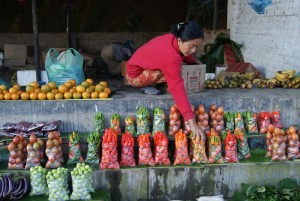 A true geographic gem, Nagaland is lushly landlocked by Myanmar in the east, Assam in the north and west and Manipur towards the south. This makes for a vibrant landscape with a climate conducive to tourism and related activities year-round. There are several mountains for trekking and gushing streams for camping out. The Mount Saramati, at 3.840 metres is the tallest mountain, followed by Japfu Peak (3.048 metres) and Mount Pauna. While each of these is a few hours’ drive from Kohima, the Puliebadze is only a few minutes’ drive – 8 km till the Jotsoma village, where you park your vehicle and begin the climb. Standing so conveniently close to the town, access to the Puliebadze is easy and it offers a decently strenuous 3-hour trek. From the top there is a near perfect aerial view of Kohima ‘village’ – which the locals proudly proclaim to be the second largest village in Asia. If you are not hard pressed for time and need more options to explore, there is the rolling verdant Dzulekie mountain, 40 km from Kohima. The Touphema Tourist Village has real tribal huts with modern amenities. But the access roads are positively backbreaking and whether they should be open to tourists is usually the diktat of a merciless weather.
A true geographic gem, Nagaland is lushly landlocked by Myanmar in the east, Assam in the north and west and Manipur towards the south. This makes for a vibrant landscape with a climate conducive to tourism and related activities year-round. There are several mountains for trekking and gushing streams for camping out. The Mount Saramati, at 3.840 metres is the tallest mountain, followed by Japfu Peak (3.048 metres) and Mount Pauna. While each of these is a few hours’ drive from Kohima, the Puliebadze is only a few minutes’ drive – 8 km till the Jotsoma village, where you park your vehicle and begin the climb. Standing so conveniently close to the town, access to the Puliebadze is easy and it offers a decently strenuous 3-hour trek. From the top there is a near perfect aerial view of Kohima ‘village’ – which the locals proudly proclaim to be the second largest village in Asia. If you are not hard pressed for time and need more options to explore, there is the rolling verdant Dzulekie mountain, 40 km from Kohima. The Touphema Tourist Village has real tribal huts with modern amenities. But the access roads are positively backbreaking and whether they should be open to tourists is usually the diktat of a merciless weather.
To reach Kohima, the nearest airport as well railway station is Dimapur from where it is a 70 km uphill drive. Called the ‘Gateway to Nagaland’, Dimapur is the ancient capital of the Kachari tribe which once lorded over the land. Ruins of temples, baths and fort embankments from the period can still be found scattered around Dimapur. But being most industrialised city in the state, this is also the busiest and is dusty. The drive up to Kohima from Dimapur will take the better part of three hours but worth the ride as you will find some of the freshest fruits and vegetables along this route. You will not regret if you horde up on some succulent oranges, pineapples and wild bananas as the Naga cooking is quite spicy.


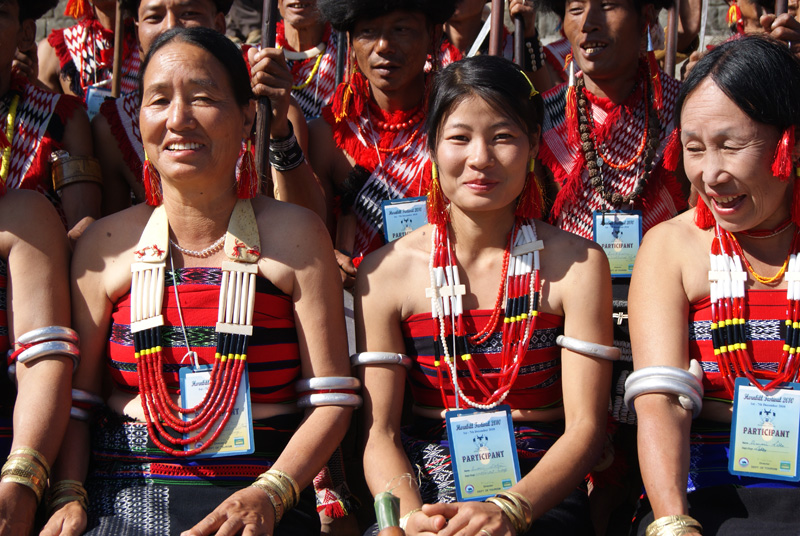









hi
Hi, Thank you for the nice words… Hope you keep coming back, posting such wonderful comments. Also pass it to as many of your buddies as possible for their inputs. The ‘Wanderink recommends’ is intended to initiate discussions. Please use that. Thanks again.
u r really doing marvelous things.cudos
u r doing great things. really proud
is Nagaland all about Kisama and Hornbill only?
Hornbill ‘opens the doors to Nagaland’…as mentioned in the title 🙂